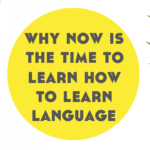Successful language learning isn’t always about speed. The best learners know how to combine speedy gains and steady growth. Here’s how.

Speedy Gains & Steady Growth: What Successful Language Learning Looks Like
Before we get started, you can enjoy this episode in the way you prefer. We’ve got a video version and the podcast below. So pick your place and let’s go!
The Video
The Podcast
How long does it take to learn a language?
I often get asked how quickly I was able to learn a language. And the truth is…it depends.
There’s so many factors that affect how long it takes to learn a language. From how much time you can dedicate to it each week, to what you do within that time. From your reasons for learning, to how those reasons change as you go on.
It’s impossible to give a simple answer to the “how long does it take to learn a language?” question. However, when you understand one key thing about how language learning works long-term, you’ll be well on your way to successful language learning.
The Problem With Quick and Easy
Ever been tempted by the front cover of French books in your local bookshop claiming it’s “Quick French”? Or “Easy German”?
Language learning is one of those things that most monolingual people claim they dream of doing.
A bucket list thing.
A “one-day-I-will” wish.
The ultimate “I’ll start tomorrow” thing.
So why is it then that so many people struggle with getting beyond chapter 3 of their shiny new Quick French or Easy German textbook?
One simple reason: our expectations are misaligned.
What people really mean when they say “I’d love to speak Spanish” or “One day, I wish to be fluent in Japanese” is that they want the result.
The click-your-fingers and as-if-by-magic result of speaking Spanish or being fluent in Japanese.
Which is understandable. Of course they want the result! We all do, right? Otherwise, why are we bothering to learn a language (or do anything) in the first place?
But what’s missing from that narrative is the bit in the middle. The actual work it takes to get that result.
You want your house to be clean and tidy, but unless you hire a cleaner, there’ll be some time spent on your hands and knees yourself scrubbing away to get that result of a clean house.
The difference between that example and language learning?
No one else can do this for you.
Sure, there are ways you can make it quicker & easier. (Learning how to learn a language is a big one).
But unless we realign our expectations first of all, this whole language learning thing likely won’t happen as quickly and easily as we hoped on day one.
Related: Mindful Language Learning (+ What It Looks Like)
How to adjust your language learning expectations
We live in a world where many of us can turn on the TV, go to a streaming service, and watch exactly the show we want to when we want to. Where I can order something from Amazon and it arrive at my door the very same day. We’ve got very used to instant gratification. It feels good.
This Veruca Salt-esque ‘I want it now!’ attitude has left many language learners feeling deflated and disappointed with the results. As we’ve said, our expectations are often skewed.
So how can we adjust our expectations to lead to a more conductive environment for language learning?
Include Milestones
Firstly, we need to include milestones and smaller goals along the way. You don’t climb to the top of Everest without checking in at basecamp. Add in some basecamps!
For example, you’re learning Arabic for a trip to Egypt in 2 months.
Rather than that being the only deadline you aim for, include milestones each week to see how you’re getting on.
Examples could include topic-based check ins. Perhaps by the end of week one, you want to be confident with greetings & introductions. Maybe week two is all about grasping the basics of restaurant and food ordering.
Not only does this help you acknowledge that you’re making progress along the way, but it also gives you a chance to check in and see if there’s any gaps forming that you need to fill going forward.
Develop Self-Compassion
There’ll potentially be weeks when you check in with your milestone and haven’t quite reached what you’d hoped for.
It’s too easy for this to be a moment of harsh self-criticism if you let it. However, it can be a chance to acknowledge that perhaps you were busy with other things, or the milestone was a lot to achieve in just one week.
How can you recognise that instead of falling into the harsh self-criticism? Developing a stronger sense of self-compassion.
We have a whole prelude lesson dedicated to this in Language Life. It explains why self-compassion is your greatest language strength.
Allow space for instant gratification
To satisfy that itch for instant gratification that we’ve grown so used to in recent years, it can sometimes be valuable to work with that rather than against it.
If you find those quick wins satisfying and motivating, there’s no reason not to include them in your language process.
Perhaps this looks like timing yourself to remember as many words from your latest vocab app session as possible.
Maybe it’s feeling proud after booking your next online lesson.
Perhaps it’s even as simple as dancing around to your favourite song in that language in the kitchen.
It doesn’t need to be overly complicated, or even the same measure each time. As long as you feel good, allow it.
Related: 50 Feel Good Language Fixes
Why Successful Language Learning Combines Speedy Gains with Steady Growth
There are moments when you’re learning a language that you need things to progress quickly. Or perhaps you simply have some extra time to devote to it for a week or so.
When this happens, you’re likely to make quick progress in a short space of time. Or, as I like to call it, speedy gains.
However, this sort of dedication, time, and effort isn’t typically sustainable long term.
You know – “life happens”! And then before you know it, your newfound every-waking-minute language routine is shattered. And you have no idea how to rebuild it.
This is where a lot of language learners fall down and don’t get back up.
Because we’ve been fed that things need to be daily, quick, easy, effortless…etc.
However, when life does happen, and you don’t have the same time, energy or dedication as you did during that phase of speedy gains, you can still keep going.
All you need is to understand what steady growth looks like for you.
Related: How to Become a Better Language Learner
What Steady Growth Looks Like
Steady growth is what happens when your language routines and habits are sustainable long term. When you’ve build something that you can maintain, even when things get busy and life happens.
It’s all about having a solid foundation of language learning in your life that allows space for difference.
There’s three things to consider here.
Track Your Language Pockets of Time
Often, when we think we’re doing very little language learning, it’s helpful to track everything and see how it adds up.
You might be surprised at how much language time is happening in your day, especially when you include all exposure like listening to music or watching something on Netflix.
And if you’re realising that there’s not as much as you’d like after trying this, then it gives you an opportunity to increase your language learning and exposure.
Get it on the calendar
If you’re the type of person who responds well to external expectations, then this one’s for you. Treat your language learning like you would a work meeting and get it on the calendar.
That way, it’s blocked out for you and you’ve got no excuse.
It doesn’t have to be hours at a time. You can simply fit 10 minutes in here and there at various moments throughout your week.
See how it feels and if it fits without too much adjustment to everything else.
Book things in advance
Following on from the last point, be sure to book things in advance – especially language lessons or exchanges that rely on someone else.
This is another idea that works well if you respond to external accountability.
Knowing someone will be waiting for you will encourage you to show up and be there no matter what.
What Speedy Gains Look Like
From time to time, you will want those speedy gains to give your language progress a boost. Think of it like a shell or a mushroom in Mario – a power boost!
Speedy gain can last as long (or as short) as you like. As long as you feel confident in being able to maintain your new routine and plan for that time, then you’re golden.
Langathon day/weekend
A good speedy gain might look like devoting a day to booking in lots of lessons with online teachers (I’ve done this annually with the Langathon for a few years now!).
It could be giving yourself a weekend to focus in on a topic and write or speak or learn as much as you can.
Starter Boost Lessons
Perhaps you want to start a new language with a phase of speedy gains. This worked really well for me with Japanese, where I was able to learn plenty of spoken Japanese without being slowed down by the script.
However, when I tried the same approach with Korean, it didn’t work as well. I think it’s because I picked the wrong tutor who spend 8 lessons on just pronunciation!
So make sure, you stay in control of the process and it doesn’t get too dry or boring to get the results you’re after.
Seasonal Shift
Using the calendar, especially seasons works really well for longer-term speedy gains.
For example, you could set a specific and measurable goal over the summer. Something like: “By autumn, I will be able to take an online A2 test in Italian and pass comfortably.”
With longer term speedy gains, make sure you’ve got a plan in place that includes plenty of milestones so you’re not left in the dark on your progress throughout.







